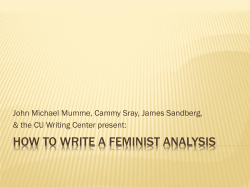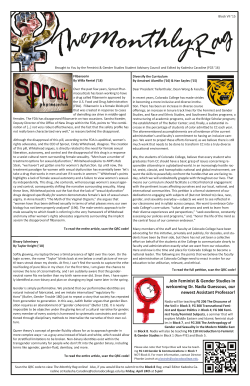
Dr Tamara Tulich - Gilbert + Tobin Centre of Public Law
Law School Using feminist legal judgments in public law teaching Dr Tamara Tulich UWA Law What worked The feminist judgment, along with its commentary, was a useful teaching resource to: • facilitate critical engagement with issues of gender diversity and the judiciary (and what we can expect of female and/or feminist judges); and • highlight the potential for different perspectives to be included in legal decision-making, the role of context and the contestable nature of the law. Introduction I used the Australian Feminist Judgments Project when teaching ‘Gender and Judging’ in LAWS3330, Gender and the Law, a 3rd year unit in the Undergraduate Law and Society Major at UWA. While this exercise was pitched at nonlawyers, feminist judgments would also be a useful resource in public law teaching. How I used feminist judgments The activity I introduced feminist judgments in a lecture that examined gender diversity in the Australian judiciary, the gendered nature of legal decisionmaking and whether women judges and/or feminist judges can make/have made a difference. The lecture was accompanied by readings on women in the Australian judiciary and feminist judging. Students were asked to prepare for the seminar by: 1. identifying differences between the judgments (e.g. interpretation of facts and inclusion of outsider perspectives); and 2. evaluating the strengths and weaknesses of each judgments (in terms of style, reasoning and compatibility with notions of fairness and impartiality). In the seminar that followed, students compared the majority judgment in Taikato v The Queen [1996] HCA 28 with a feminist legal judgment written by Penny Crofts and Isabella Alexander. This judgment, along with a commentary by Julie Stubbs, is published in Douglas, Bartlett, Luker and Hunter (eds), The Australian Feminist Judgements: Righting and Re-writing the Law (Hart, 2014). In the seminar, students were divided into groups of 4 to discuss the judgments and then report back to the class on the above points. The purpose of the exercise was to highlight the contestable nature of the law and the potential for different perspectives to be included in legal decisionmaking. A further purpose was to facilitate discussion of the significance and limitations of feminist judging. Students reported that they enjoyed: • studying the feminist judgment as it demonstrated that feminist legal scholarship could have a practical impact; and • having the opportunity to compare the two judgments and discuss the differences. What didn’t work For non-law students, the exercise was challenging. I didn’t distribute the commentary to students, but used it as a teaching resource. On reflection I think it would have been more useful to distribute the commentary with the judgment, in particular for those students who weren’t as confident reading and discussing judgments. In public law teaching, the commentary would assist students to become acquainted with feminist judging techniques and the broader context of the decision.
© Copyright 2025



















